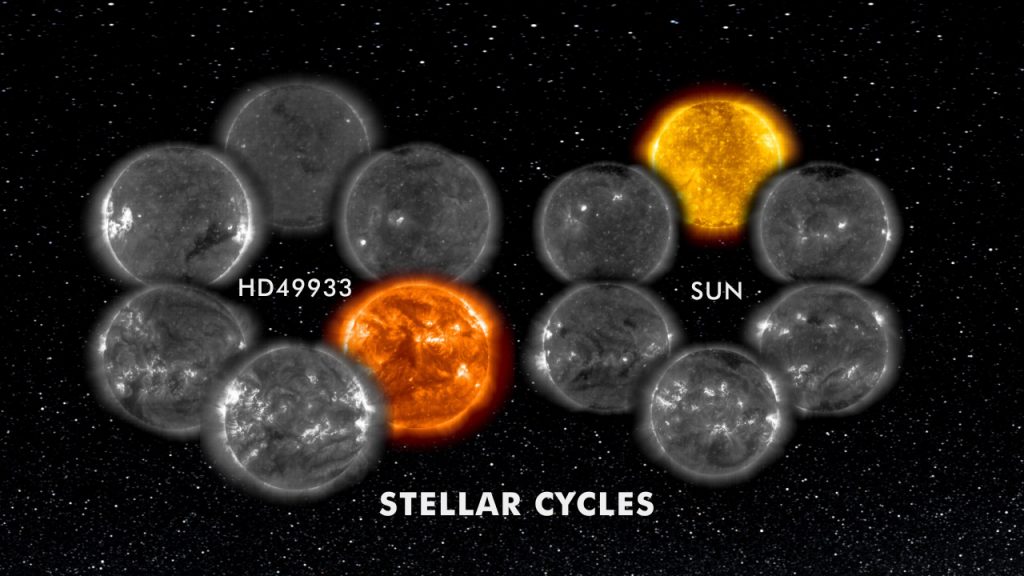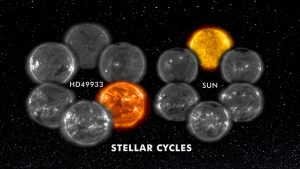The CoRoT satellite reveals the magnetic cycle of a star
An international team[1] led by a CEA astrophysicist of the AIM Laboratory- Astrophysics Department of the CEA-Irfu has observed, for the first time, the cycle of magnetic activity in a star using stellar seismology – the study of vibrations in a star. The observations of HD49933 by the CoRoT[2] satellite revealed an cycle of magnetic activity identical to that seen in the Sun, but much shorter. This result paves the way for many stars to be examined using the techniques of asteroseismology, for a better understanding of the mechanisms responsible for activity cycles, including the Sun’s. The results were published in the journal Science on 27th August 2010.

This animation shows the evolution of the Sun based on snapshots taken by ESA’s SoHo satellite from the solar minimum in 1996 to its maximum in 2001. The Sun has an 11-year cycle. The CoRoT satellite’s observations of star HD49933, combined with the stellar seismology technique, made it possible to determine a similar, but much shorter, activity cycle – roughly 20 times faster (second part of the sequence). Animation credits: Gabriel Pérez, Instituto de Astrofísica de Canarias (IAC)-Servicio MultiMedia. Images: ESA/SoHo.
For more information : see the full text in French
Contact: Rafael Garcia
“CoRoT reveals a magnetic activity cycle in a Sun-like star”
Rafael A. Garcia(1), Savita Mathur(2), David Salabert(3,4), Jerome Ballot(5), Clara Regulo(3,4), Travis Metcalfe(2), Annie Baglin(6), Science, Vol 329, 27 August 2010, Vol 329, N. 5995, p. 1032
electronic version, pdf file
(1) AIM Laboratory (CEA-IRFU, CNRS, Université Paris Diderot-Paris 7) (F), (2) HAO/NCAR (USA), (3) IAC (SP), (4) Université La Laguna (SP), (5) Obs. Midi-Pyrénées (F), (6) Obs. de Paris (F)
See: the joint press release from CEA, CNES, and CNRS
Press release from NCAR (in english)
See also : – “Pulsations d’étoiles” (Star Pulsations) October 2009
: – “Tremblements stellaires” (Starquakes), March 2010
Notes :
1) The international team includes French scientists from the AIM Laboratory (CEA-Irfu, CNRS, université Paris Diderot-Paris 7), Midi-Pyrénées Observatory (LATT: CNRS, Université de Toulouse, OMP-INSU) and the Paris Observatory (LESIA: Paris Observatory, CNRS, Université Pierre et Marie Curie, Université Paris Diderot-Paris 7); Spanish scientists from Instituto de Astrofísica de Canarias (IAC); and American scientists from the National Center for Atmospheric Research (NCAR).
2) The CoRoT satellite (Convection, Rotation and planetary Transits) is a mission developed by CNES in collaboration with the ESA, Austria, Belgium, Brazil, Germany and Spain. The satellite was launched in December 2006. CoRoT is equipped with a 27-cm diameter telescope combined with a camera with four CCD (charge-coupled device) detectors, sensitive to very small variations in the light intensity of the stars.
Written by: R. Garcia, S. Mathur, C. Gouiffès


